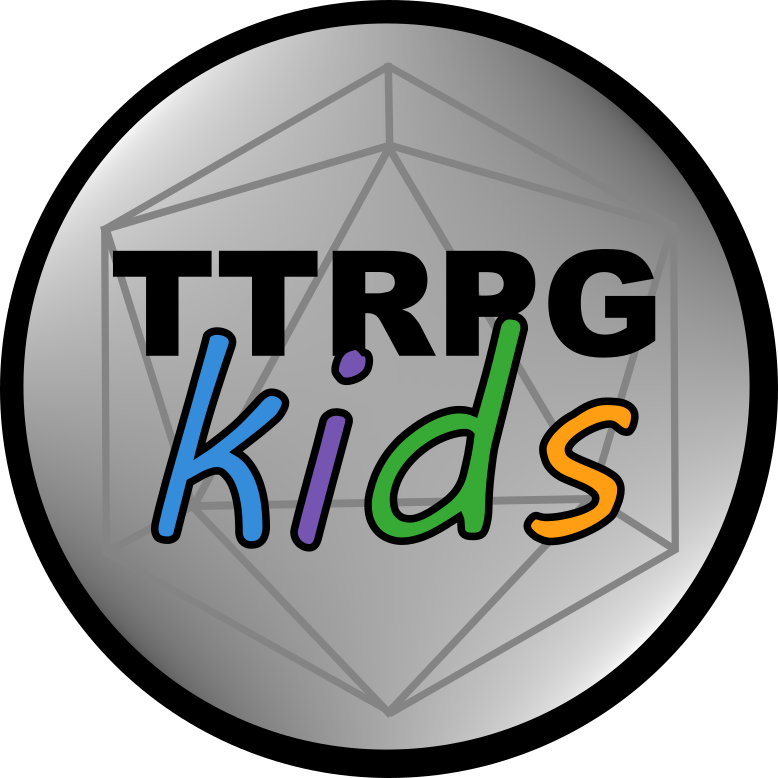Review of Inkforged
Jump to:
*note that this review is via a playtesting version of the game, so some of what is described below may differ slightly from the final version of the game
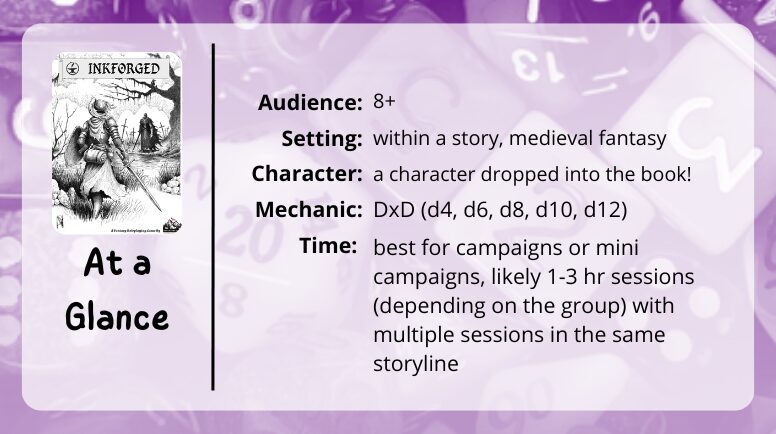
Note: This post may contain affiliate links. At no additional cost to you, I may earn a small commission from purchases made using them. TTRPGkids uses this to keep the site going. Read full disclosure here.
To support the project or get a copy, you can follow the Kickstarter here, and get a free copy of the quickstart here!
Target audience for Inkforged
I would say that Inkforged is probably for players about 8+ based on the reading required. I thought it gave a good balance between intuitive mechanics (very straightforward process for rolls/checks) and allowing a bit of crunch (i.e. lists of abilities under different skills and ways to customize your characters, spells, etc). For young kids (under 8), they could probably handle the rolls but may need a bit of help with character planning. For players who are OK with reading and tracking, I think the range of character customization has a great appeal.
Regarding content, there is a general setting and concept for the game, but the specifics of your adventures and how intense you want it to be is entirely up to you and your group. There’s some scary-ish foes, but nothing that seemed too far out there to me, and the narrator and players are given control over what content they can choose.
Setting in Inkforged
Inkforged’s setting is a bit interesting, and I really liked it. The main concept is that your character is in the “real world” and is chosen to be pulled into a particular story that needs their help. Once in the story… they become one of the book’s characters. And, while the game does lean towards a medieval fantasy setting, this book could be anything – a novel, a comic, a picture book… you name it.
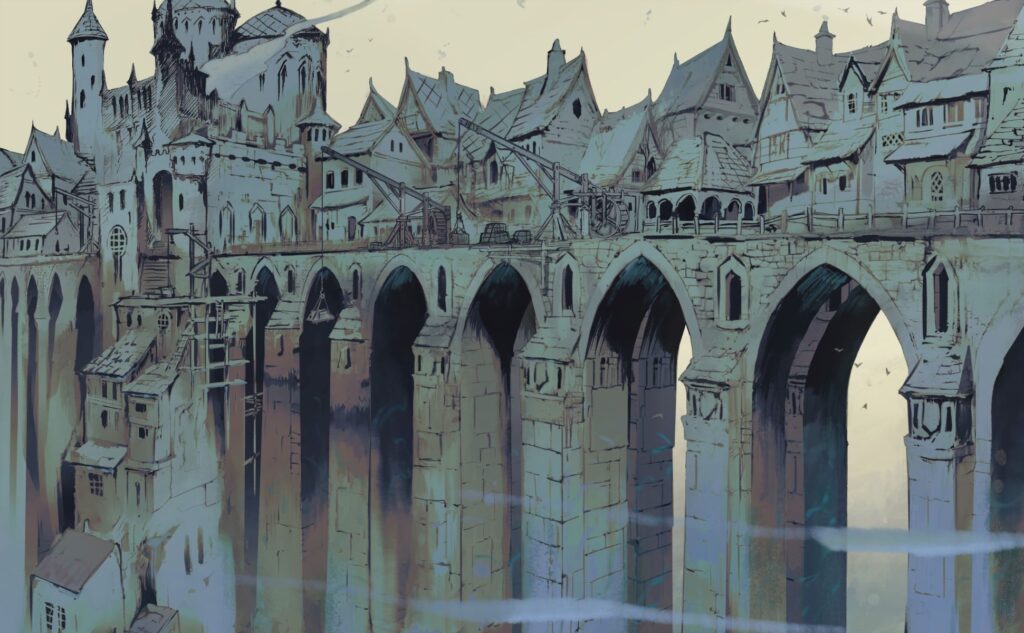
Then, the rest of the game takes place in the book.
Throughout it, you’ll run into challenges that fit a story you choose or make up, and can encounter corrupted antagonists who may make things veer a bit off canon for a particular tale (like stealing away the story’s classic hero or introducing a wildly overpowered foe). There’s also magic from the writer, in the form of their ink, dripped throughout the world, which you can harness and use for magic and impacting the story.
Having everything take place in a book was really cool to me since I can’t tell you how many times I wished this was a thing growing up. Seeing it as the foundation for the story and then also having the mechanics and lore tied into that (versus just having you jump into the story and forgetting about it being in a book) was pretty amazing.
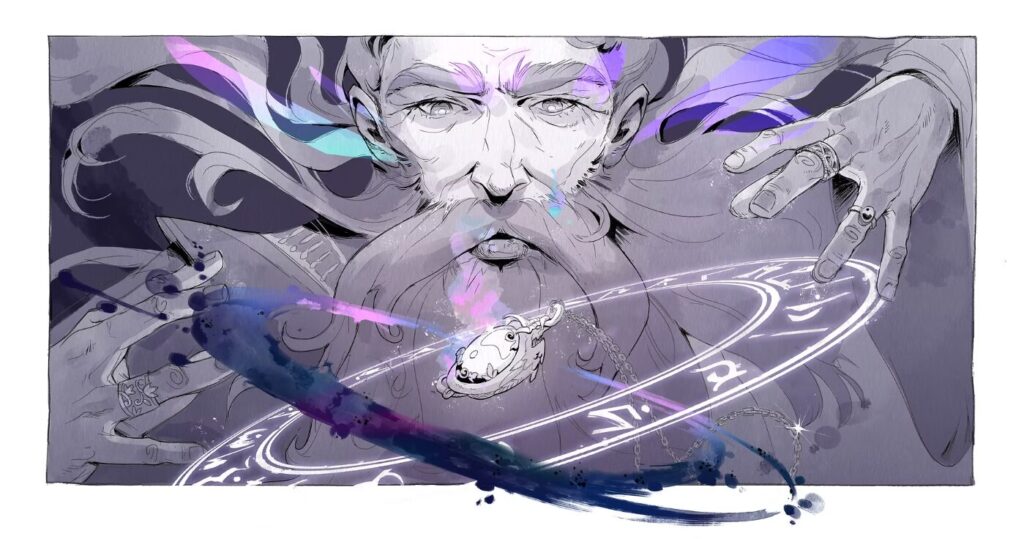
Your Inkforged character
Like I mentioned a bit before, characters in Inkforged start as a person in the “real world” who then gets transported into the book and transformed into their book-persona. You create your character by defining a few basics about their origin (prior life details, a core strength and flaw, etc), and then dive into creating their book counterpart.
Your in-book character will have 5 traits (Agility, Brawn, Instinct, Mind, and Will) and 5 skill groups (Adventure, Combat, Magic, Social, and Sneaky) that you’ll assign dice to in order to show how strong each trait or skill group is. You’ll also get a boon and choose a special skill in the beginning, like acrobatics or magic, that unlocks a specific list of abilities.
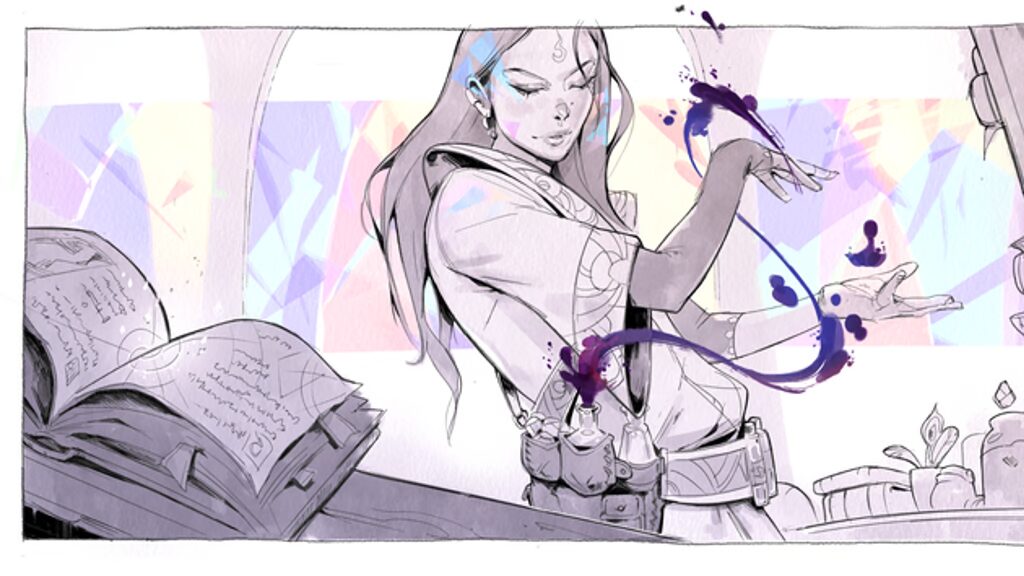
Your defense, health, skills, mana, etc are all then defined by a combination of your traits and skill groups, so it kind of calculates the rest of your character for your after you’ve chosen your dice for your 5 traits and skill groups (which I really liked… it was super easy and then naturally fit what my character build trended towards).
For my character, I rolled for my boon first and got “Fast Healer”, so I decided to play with that as I built my character. The concept I went with was that they were a writer who, as a result of their healing abilities, happened to often be the one left to tell the tale at the end of various encounters. I made their highest trait Mind (Mi) and their highest skill group Adventure (Ad), choose the healing skill (which is Mi + Ad for rolls), and set them up for learning magic and a set of healing and force spells later. I gave them a strong Brawn (Br) trait as well so they would have a lot of health (which is determined by Br + Ad) AND could keep going for a long time, even if they sustained tougher wounds from hitting zero health repeatedly (Br impacts how you handle long term wounds).
I had A LOT of fun building up this clumsy and kind of horrible fighter (low Agility, Instinct, and Combat) who basically just survives because they have a lot of healing going for them. I tried them out in a combat mock up, and it ended up working out pretty well! They may take a few hits and have to take (a little) time to heal their wounds, but that just gives them some downtime later to practice their trade and write about their mishaps.
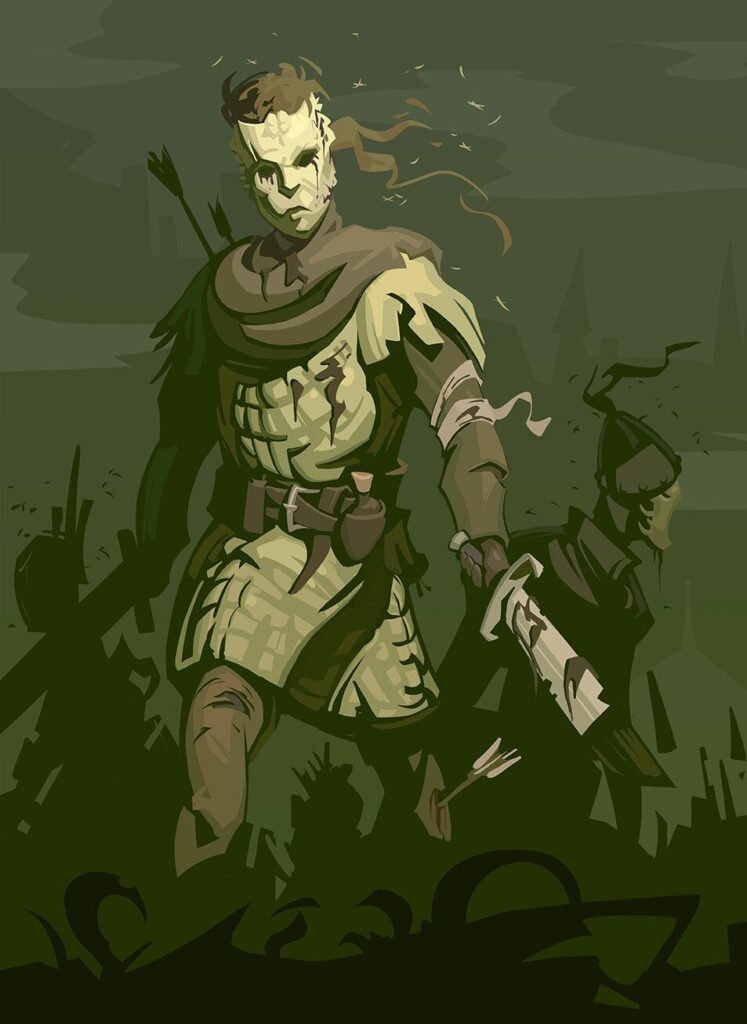
Mechanics in Inkforged
Inkforged uses the Defined by Dice system (or DxD), which assigns a d4, d6, d8, d10, and d12 die to each of your traits and skill groups for rolling. This means that for your strongest trait, you’d assign a d12 so that you can potentially get a 12, while your lowest trait would be assigned a d4, so a maximum of a 4 for the roll.
When you roll for a skill, you’ll roll the die for the trait and the die for the skill group that applies, add them, and then add any modifiers you have from skills, boons, etc. So, for my turbo healing character, when I want to use my healing skill, which is associated with the Adventure (Ad) skill group and the Mind (Mi) trait, since I maxed both out with my d12’s, I would roll a d12 + d12 + a bonus for having the skill unlocked.
When you roll for a straight trait, it will be similar; you’ll roll your trait die twice, add them, and add any bonuses. So, for my clumsy character making an Agility (Ag) check to try to weave through a series of obstacles quickly, I would roll 1d4 + 1d4 + 0 (no modifiers) – I am probably not going to do so well there (but that’s fine because my character will fall on their face, get hurt, and heal up).

And most of your rolls will boil down to this kind of mechanic, which was something that was super easy to follow!! However, I don’t want anyone to think the mechanics end here. Behind the scenes, there’s creative ways that your defense, health, etc are determined by your skill groups and traits and how all your skills explode into a wide range of options for special moves (which I won’t get into because I don’t want to spoil EVERYTHING). There’s nuance to how your character going down is handled (i.e. you don’t just go down), and there’s some fun things that happen if you roll the max on both dice or two ones. The point here is that during game play, your core rolls are pretty straightforward to follow so it makes sense and is intuitive while tapping into multiple elements of your character build and pushing their story forward.
I also want to talk about Edit Points – instead of leveling up or gaining XP, you can earn Edit Points, or EP, as assigned by the narrator. These EP can be turned in to unlock some fun stuff for your character that YOU choose. You can modify spells, unlock a new profession or skill, increase your die for a skill, and more… and it’s kind of framed like you being able to edit things about your character in the book. It’s a great way to progressively increase the complexity without being locked into one particular character class, when both the players and characters are ready to do so. You unlock a new set of skills after you’ve already mastered the set that you started with, and that newly unlocked element can be from anything in the book.
Beyond this, there is A LOT more that I want to get into, but you will have to play the game to discover the secrets and intricacies, particularly of the higher level/story manipulation elements and whatnot (which are REALLY fun and I enjoyed planning out for my character’s level ups).
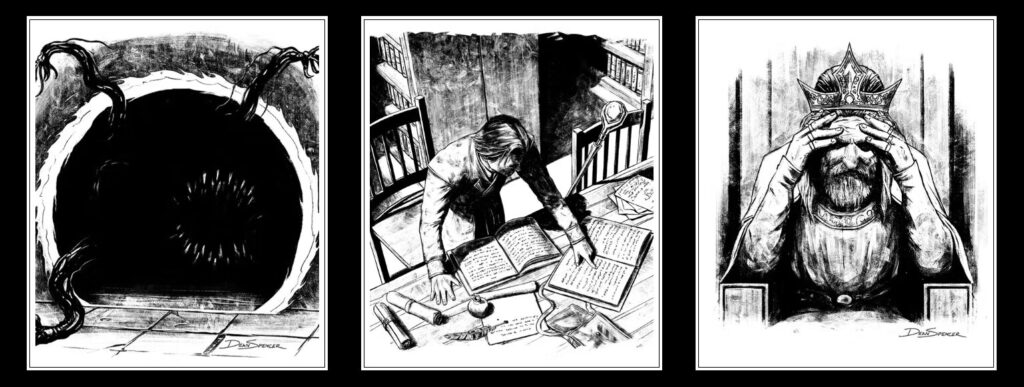
Overall thoughts on Inkforged
I loved the concept of Inkforged, and I really liked how the mechanics played out. This was one that I think had a really good balance of options for fluid gameplay and being able to get VERY creative within a set of well defined mechanics. When I was a kid, I loved finding ways to move around within a set of game rules, and this let me do that while framing it in a scenario (jumping into a book) that inner 10 year old me was really happy about.
The character creation process hit some special notes with me as well, and this super healer character who just kind of stumbles in and out of situations… I’m keeping them. The method for character building in Inkforged facilitated a great step-by-step in making a persona full of personality and with a fun background that just sort of developed more and more as I had to assign some really low dice to a few traits and skill groups, and I am all here for it.
As a closing, too, I want to say that another point that really stuck out to me was that the mechanics specifically list the importance of character development. A requirement for Inkforged is that characters enter the realm and become this new person, and, when they leave to return to their lives, they take with them some kind of lesson that helps them better themselves. This was really important to me, especially in relation to books and how they can reach inward and help you see things from a different perspective or grow in some interesting way vicariously through the individuals in the story. Everything is framed around this, and I think this is part of what made my playthrough feel special and why I enjoyed trying out Inkforged so much. It is focused on growth and self development and that, sometimes brief moment, when you connect deeply with a book and it impacts you from that point onward.

Find a copy of Inkforged
Inkforged will soon be going to crowdfunding, and you can find the Kickstarter page here!
In the meantime, you can find out more information about Inkforged on the creator’s website here and can get a free copy of the quickstart here!
And… if you liked this post, make sure to subscribe to the TTRPGkids monthly newsletter to stay up to date on the latest reviews, tips and tricks, game and podcast list updates, and more! Thank you for playing tabletop RPGs with your kids and sharing this awesome hobby with the next generation!
